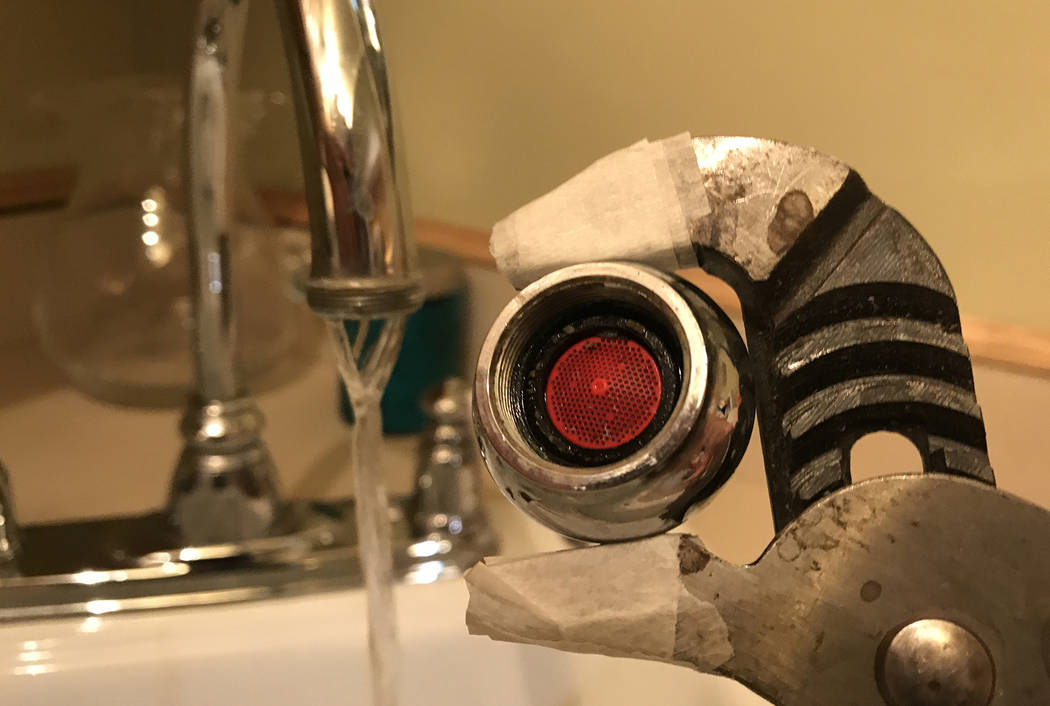Clogged aerator may reduce water pressure
Whenever we turn on our faucets, we expect a good level of water pressure and steady column of water flow. Our local utility company initially controls water pressure to our home, but many factors can reduce water pressure. When your faucet doesn’t have enough oomph to, say, rinse off a plate, or flows irregularly, there are basic DIY repairs a homeowner can make that don’t require special plumbing skills.
Lack of pressure and messy flow are commonly due to a clogged aerator. Interestingly, most folks don’t know what an aerator is when it comes to plumbing. An aerator is a small device screwed on to the tip of a faucet. It contains a screen(s) that does two things: filters out particles and creates a smooth, neat flow of water. The screen forms many tiny streams as the water passes through it, ultimately introducing air to the water flow. Without it, the water would chug-a-lug out of the spout. Aerators make the water whiter, softer and nonsplashing.
Especially with our locally classified “very hard” water (>180 ppb), over time, these aerator screens get clogged with mineral deposits and cause the water to lose pressure. These particles may also cause the spout to sputter and squirt.
Simply cleaning or replacing an aerator will get the flow strong and smooth, once again.
Before starting the project, keep in mind:
■ Whenever you take something apart, be sure to remember what order they go in. In this instance, place the aerator parts down one at a time from left to right (as if you’re creating an “exploded” view). Then work from reverse when putting it back together.
■ Some aerators are flush within a wider nozzle, making them less obvious to locate and remove. Look for flat ridges on the aerator where you’ll grip the pliers.
What You’ll Need
Penetrating oil, rag, old toothbrush, tongue-and-groove pliers (with taped jaws so you don’t mar the faucet finish)
The project:
■ Close the drain so you don’t lose any parts.
■ If the faucet is older or you can see built-up mineral deposits around the aerator, spray it with penetrating oil and let it soak about 15 minutes.
■ With the pliers, unscrew the aerator (turning clockwise).
■ Brush out the screen. Depending on the aerator, there may be more than one screen with accompanying rings. Carefully pull them apart and brush out the particles.
■ Run the water without the aerator in place; you may be surprised at what comes out.
■ Reassemble the aerator and screw it back to the faucet.
■ Snug it tight with the pliers.
If you find excessive corrosion or can’t clean the aerator without destroying it, just replace it. Be sure to take the old one to the hardware or plumbing store for the right fit.
For the water conservation minded, there exist high-efficiency aerators that are “low-flow” (use less gallons/minute than standard aerators), but because of their design, provide steady powerful pressure. Some are also designed to resist lime buildup.
If you’ve cleaned or replaced your aerators and your water pressure is still low, you likely have a clog in your faucet cartridge. This repair will require cleaning or replacing the cartridge. While a cartridge repair may be considered a “beginner” DIY skill level, I’ve seen many people stymied at step one — when shutting off the water valve produces a leak or won’t even turn at all (due to corrosion).
If the pressure at all of your faucets seems low, the likely culprit is your water softener. A simple method of testing all of your home’s water pressure is with a pressure gauge that screws to an exterior hose spigot (around $10). In Boulder City, normal water pressure is between 50 and 80 psi. If your pressure is out of range, contact the city’s Public Works water division.
Norma Vally is a seasoned veteran of home improvement; her career includes four seasons as host of Discovery Home Channel’s Emmy-nominated series “Toolbelt Diva.” A columnist and author, Vally splits her time in Southern Nevada, Los Angeles and New York City. Follow her on Facebook at Norma Vally “Toolbelt Diva” and visit her at www.NormaVally.com. Email Norma@NormaVally.com.









